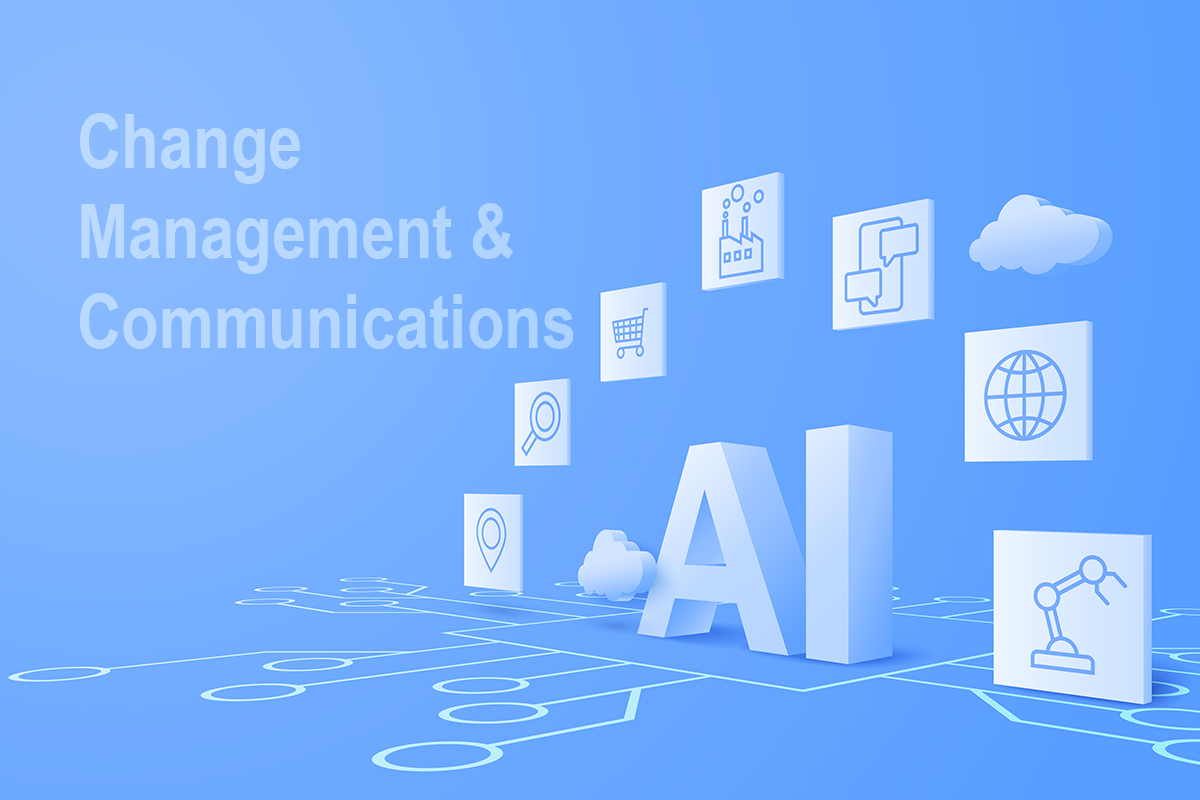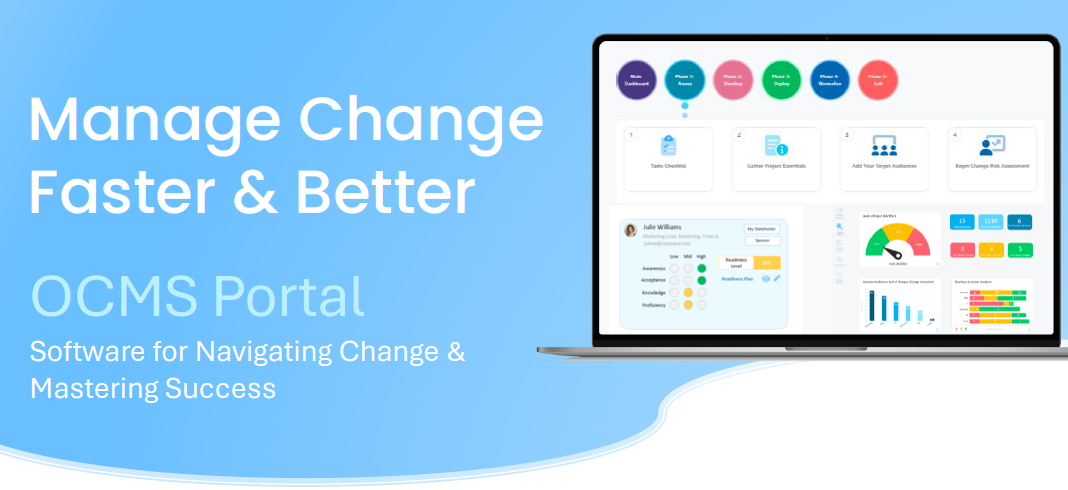AI and Communications: A Powerful Duo for Effective Change Management
The digital revolution continues to reshape the workplace landscape. Artificial intelligence (AI) is no longer a futuristic concept; it’s actively transforming industries and influencing how we work, including through AI in communications and engagement.
While AI brings undeniable benefits, its implementation often necessitates significant changes to workflows, processes, and even company culture. Here’s where the human element steps in – effective change management and communication become crucial for smooth organizational transition.
Generative AI is a powerful branch of AI adept at creating human-quality text formats. This technology holds immense potential for crafting persuasive messages that resonate with employees during change initiatives.

Let’s delve deeper into how AI generated emails and other communication can be leveraged to navigate the complexities of change management in the workplace.
Watch a summary below:
Story Highlights
|
Why Effective Change Management and Communication Matter
Change, by its very nature, disrupts the status quo. In the workplace, even positive changes can trigger uncertainty and resistance from employees accustomed to established routines.
This is where effective change management comes into play. It’s a structured approach to guiding individuals and teams through transitions, minimizing disruption, and maximizing employee buy-in.
Communication is a core element of effective change management, especially when it comes to AI in the workplace. The absence of a strategic communication plan during company changes, like digital transformation, creates a void that can be filled with anxiety and change resistance.
The key pillars of successful change management include:
- Clear communication: Keeping employees informed throughout the change process is paramount. This involves explaining the rationale behind the change, its potential impact, and how it will benefit the company and individual employees.
- Transparency: Honesty and openness foster trust during periods of change. Be transparent about potential challenges and how the company plans to navigate them.
- Employee engagement: Actively involve employees in the change process. Seek their feedback, address their concerns, and encourage open dialogue.
- Training and support: Equip employees with the knowledge and tools needed to adapt to the new way of working.
When these elements are addressed effectively, change management and communication pave the way for a more seamless transition, improved employee morale, and ultimately, the success of the new initiative.
Are you leading or responsible for a mid-to-large project implementation? We can help. Learn more about how Airiodion Group can help you and your organization: Top Rated Change Management Consultants.
Learn more about how Airiodion Group can help you and your organization: Top Rated Change Management Consultants.
The Power of Change Management AI in Tailoring Change Communications
While traditional change management strategies like town halls and email blasts serve a purpose, they can miss the mark of personalized communication. This is where generative AI in communications shines. It can analyze vast datasets to understand employee demographics, communication styles, and preferences. Armed with this data, AI can tailor communication and change in the workplace in several ways:
- Personalized messages: AI for communication can generate targeted emails or messages that address individual concerns and highlight specific benefits relevant to each employee’s role or department.
- Language style adjustments: Communication with AI can adapt the tone and style of communication based on employee demographics. For example, younger employees might respond better to a more informal and concise approach.
- Microtargeting: With AI and communications, you can segment employee communication based on their likely concerns or areas of curiosity. For example, a team heavily reliant on manual data entry might receive more details on how automation will streamline their work.
- Data-driven storytelling: Tools for AI in the workplace can analyze data to identify real-world scenarios and case studies that resonate with employees. This helps paint a clearer picture of the positive impact the change is expected to bring.
- Interactive FAQs: Chatbots powered by generative change management and AI can provide employees with a readily available and personalized platform to access information and address their concerns about the change in real time.
By incorporating these AI-in-the-workplace tactics, you craft change communication that feels personal, relevant, and engaging. AI for employee engagement can foster a sense of ownership among employees, increase their understanding, and ultimately drive higher levels of buy-in.
Don’t miss: 10 Powerful AI Prompts for Better Change Management Results
Do you have any questions about artificial intelligence in business communication or AI employee engagement? Please reach out and let us know!
Beyond Efficiency: Ethical Considerations for AI in Communication
While generative AI offers a powerful tool for change management and communication, it’s crucial to approach its implementation responsibly, especially when using AI for customer engagement and AI employee engagement strategies.
Here are some key ethical considerations to keep in mind:
- Transparency: Be upfront about the role of AI in communications. Employees should recognize that some communication might be generated by AI, while more complex topics require human interaction.
- Authenticity: AI generated emails should feel genuine and human-like. Edit as needed to avoid overly promotional or robotic language.
- Bias mitigation: Artificial intelligence and communication models are only as good as the data they are trained on. Ensure that training data for generative AI is diverse and inclusive to avoid perpetuating biases.
- Human oversight: AI in the workplace and AI for communication should be used to enhance, not replace, human communication. Employees still need access to human managers and leaders for addressing concerns and receiving support.
Please let us know if you have any questions or feedback about AI and communications or how to use artificial intelligence and communication in change management. We’ll be happy to help!
The Role of Humans in a Changing Workplace
The rise of AI and the use of artificial intelligence in business communication shouldn’t be seen as a threat to human interaction. Instead, AI can be leveraged to free up human resources from routine communication tasks, allowing them to focus on more strategic initiatives.
Here’s how human expertise remains vital in change management and communication.
Leading by Example
Managers and leaders play a crucial role in setting the tone and fostering a culture of openness and trust during change initiatives. Their active participation in communication and their enthusiasm for the upcoming changes can greatly influence employee perception and the use of AI for employee engagement.
Active Listening
Changer management AI communication can gather data, but it can’t truly listen to employee concerns. Human leaders need to actively listen to employee feedback, address their anxieties, and provide reassurance throughout the transition.
Mentorship and Coaching
As employees adapt to new workflows or technologies, human managers can provide essential mentorship and coaching. This personalized support helps employees feel empowered and equipped to navigate the change successfully.
Building Relationships
Ultimately, successful change management and communication hinges on strong relationships between employees and leadership. While AI for customer engagement and employee communication with AI can facilitate conversation, genuine human interaction fosters trust, collaboration, and a sense of belonging during periods of change.
By combining the efficiency and personalization of AI generated emails and other messaging with the empathy and leadership qualities of humans, organizations can craft a winning approach to change management in the AI-powered workplace.
The Road Ahead: Embracing AI and Communications for Effective Change
The future of work is one where humans and AI collaborate seamlessly. While AI in the workplace offers a powerful tool for tailoring change communication, it’s not a stand-alone solution.
For a successful transition, consider AI as a value-adding partner in your change management strategy. Here are some final thoughts to guide your change management and AI communications approach.
Start Small and Iterate
Don’t try to replace all your communication with AI generated emails and messaging overnight. Begin with smaller-scale initiatives and test how the combination of artificial intelligence and communication resonates with employees.
Gather Feedback
Continuously seek employee feedback on the effectiveness of your OCM communication and change in the workplace, including AI-generated components. Refine your approach to AI employee engagement based on their input.
Focus on the Human Element
Generative AI can be an effective tool but don’t underestimate the importance of human interaction. Combine AI-powered change management and communication with genuine two-way communication to build trust and foster a culture of continuous learning and adaptation.
By embracing AI in the workplace in a responsible and human-centric way, organizations can craft persuasive change messages that resonate with employees. This paves the way for a smoother transition, increased employee engagement, and ultimately, a more successful future where humans and AI work hand-in-hand to unlock the exciting potential of the changing workplace.
Please let us know if you have any feedback about using change management AI for communication. We’d love to hear from you!
Automate Your Change Management and Communication Plan
Whether you’re using AI and employee engagement messaging or driving an adoption initiative for AI in the workplace, you need the right tools for the job.
OCMS Portal is a cloud-based change management platform that provides the direction and tools you need to execute a successful OCM strategy. This includes real-time reporting, auto-generated engagement plans, and more to power effective communication and change in the workplace.
Learn more & start your free trial.
FAQ: AI and Communications for Change Management
Why are change management and communication important to organizational change?
Change, by its very nature, disrupts the status quo and can trigger uncertainty and resistance from employees.
Effective change management (with communications at the core) is a structured approach to guiding individuals and teams through transitions, minimizing disruption, and maximizing employee buy-in.
How does change management and AI in communications help OCM teams?
Generative AI for customer engagement or employee engagement can analyze vast datasets to understand demographics, communication styles, and preferences. Armed with this data, AI can tailor change management communications, including providing AI generated emails with personalized messages, making language style adjustments, microtargeting by change impact, and helping to generate interactive FAQs.
How can you balance the human component of communication with AI?
Generative AI and employee engagement during changes can be a helpful tool, but don't underestimate the importance of human interaction. Make sure to edit AI generated emails and other content to ensure it keeps a human touch. Also, combine artificial intelligence and communication with genuine two-way dialog with the change management team, change champions, and leaders to build trust and foster a positive culture of AI in the workplace adoption.
Do you need change management consulting support or help?
Contact Airiodion Group, a specialist change management consultancy that supports organizations, project managers, program leads, transformation leaders, CIOs, COOs, and more, who are navigating complex transformation initiatives. For general questions, contact the OCM Solution team. All content on ocmsolution.com is protected by copyright.
External Sources: stock.adobe.com




